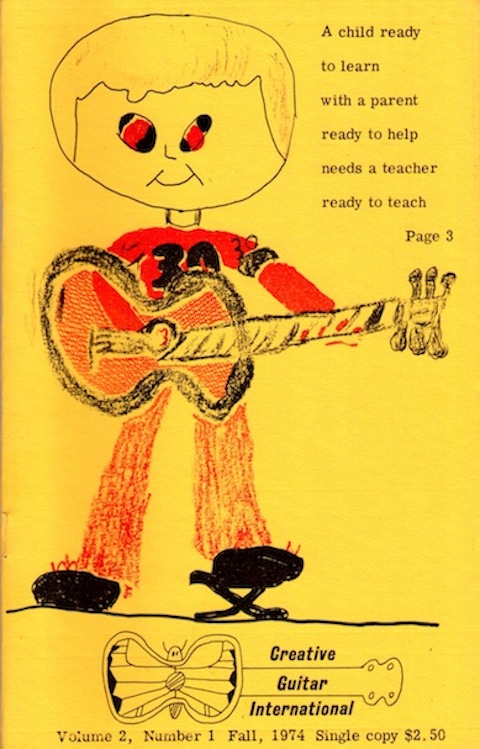
|
|
||
 |
||
|
|
||
Content highlights:
Young players
Scott Tennant at 12
Ponce music attributed to others
Different way to count
Guitar repair
|
|
|||||
|
creative guitar international
© 1974 by Ruth and Jerry Mock, Creative Guitar International is a classic guitar magazine published three times a year, in the fall, winter and spring by Mockingbird Press, Box 1275, Edinburg, TX 78539 Subscription rates $5 a year; two years $10 contents:
Let's give the kids a break 3 Guitarist with a purpose 6 In lieu of a review (In search of the 6th string) 7
|
Some curious
omissions 11
Letters 13
Publications received 17
Um pa la a (Note reading, rhythm
help) 19
Practicable practice 20 Guitar repair: Finish
touch-ups, matching
colors 22 Chamber group backs
Romeros 24
Interesting excursions 28
Workshops 29
Guitar on campus 31
Strictly guitar 32
First graduate 34
Records 35
|
||||
|
Musical greats: Talent
|
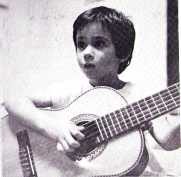 |
||||
|
or
|
|||||
|
Opportunity
|
|||||
|
|
|||||
|
Reed Sicherman, 5
|
|||||
|
|
|||||
|
Editor/Jerry Mock; pedagogy editor /Ruth Mock. Other contributors, in addition to those named elsewhere in this issue, include: France, Robert Vidal; Texas, Frank Wagner; Virginia, Grete Dollitz; and Wisconsin, Michael Wright. Cover picture of the football player with a guitar by Nelson Mock, 6.
Our librarian, language consultant, Marilyn Nicely, also made the drawings on pages 8, 17, 19, 30 and 31.
The action sketch of Frank Costa at the Lopez Ramos workshop (page 31) was drawn by the Rev. Daniel A. Creagan.
The photo on page 32 (below) was taken by Lucia Aandahl.
|
Parents are concerned with the question: When is the best age for the child to start guitar? Mozart was said to have played chords on the clavier at three and composed at five. Beethoven began his musical education at five. Standard music encyclopedias indicate that musical schooling was begun about the same time that the public schools begin today. Bach, Brahms, Berlioz. Villa-Lobos, Charles Ives, all began studying music early. It appears that one could establish that persons generally considered musically gifted had an early music education.
Most of these gifted musicians had one other thing in common: They were taught by a member of the family, generally a father. Ives, for instance, remembers experiments by his father in quarter tones, polytonality and acoustical phenomena. His father taught him piano, violin and trumpet.
The father of Brazilian Heitor Villa-Lobos, an amateur
|
||||
|
|
|||||
|
|
||||
|
4
|
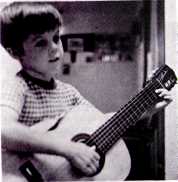 |
5
|
||
|
musician, instructed his son in music. At eight Villa-Lobos could play the cello and several wind instruments belonging to his father. Brahms' father was a double bass player who taught his son violin and cello.
In his Guitar and Mandolin, recently republished by Schott & Co. , Ltd. , London, Philip J. Bone writes in a similar vein about guitarists.
Bone wrote that Matteo Carcassi studied guitar as a youth and had "natural musical endowments."
Bone wrote that Fernando Sor at five composed "little airs which he played on his father's violin and guitar."
Tarrega had his first guitar lesson at eight. Napoleon Coste played guitar at six, Bone wrote, adding that the guitar was "an instrument of which his mother was exceedingly fond and on which she was a capable performer."
If we consider the present day, we find the pattern has not changed appreciably. John Williams began studying at six under his father. Angel Romero made his debut at 13; all the Romero sons began playing guitar at three. Andres Segovia began at ten. Julian Bream took up the piano at ten, but a year later changed to the guitar. Christopher Parkening began studying guitar at 11.
Oscar Ghiglia started at 15, but said he would be better technically and in interpretation if he had started at seven.
Even with a minimum of research we can come to a reasonable conclusion that many of the great musicians started at an early age. Bone, as well as other musical sources, usually lists these people as exceptionally talented when young. Were they exceptionally talented, so began their studies early; or were they exceptionally talented because they started their studies early ?
Let us assume some attributes of a gifted child. Let us
|
A child ready to learn with a parent ready to help needs a teacher ready to teach.
|
|||
|
Marc Hagler, 6 say he has some or all of the following: 1. An ability to follow instructions and to practice methodically. 2. An ability to count. 3. Persistence. 4. An ability to find weaknesses and practice them. 5. Guidance from someone. 6. A routine in which he spends a certain time in daily practice. 7. Performance early, so he can get used to playing in front of someone. 7. Finger dexterity from practice. 8. An ability to read (music) well. It seems that, within reason, the earlier a child begins his music studies, the more of the above he can develop, especially if aided by a member of his family in his daily practice. From the above, perhaps, we can arrive at an age.
The language people say a child at three and one-half can, under the proper circumstances, develop an amazing facility in language. He is ready, so to speak, to learn many things, including music. But we cannot expect every guitar teacher to deal with a child of three. Progress of a three-year-old is very slow and difficult to measure. The six-year-old starting to school will progress much more rapidly than the three-year-old. He can be taught a great deal of theory, sight-singing and counting, as well as the instrument. They all learn. It depends somewhat on the teacher and the
|
||||
|
|
||||
|
|
|||
|
6
parent. The younger the child, the more the responsibility rests with the parent.
Music teachers have a tendency to shy away from the younger child, just as parents hesitate to "push" their child. But a child ready to learn should get that chance, with the parent spending a half-hour a day guiding the child through his lessons. Why not give him an intellectual opportunity: To start early to become a mature musician.
Children are being taught violin and piano at a very early age. Under the Suzuki program children without previous aptitude or intelligence tests have shown great progress. Shinichi Suzuki writes that "It is wrong to assume that special talent for learning music, literature or any other field is primarily inherited."
But children as young as three are successfully taught classic guitar in South Texas. A recital by students of Douglas Rice in Seattle, Wash., included nine numbers played by children six to 11. The music included Bach, Bartok and Satie.
Creative Guitar International would like to hear from others teaching the very young. We also would like to see the teaching of the very young included in the national guitar symposium planned by the American String Teachers Association next year. Inclusion of young children will give the classic guitar scene a more mature outlook.
Twelve-year-old Scott Tennant of Detroit is a guitarist with a direction and a purpose.
He wants to study at the Royal Academy of Music in London and "pass on the knowledge and the beauty of the guitar to as many people as I can."
The parents, Mr. and Mrs. Edward A. Tennant, bought
|
little guitars and banjos for Scott and his older brother, Roddy.
One Christmas, they bought Scott a real guitar. "Just to look at it was wonderful," Scott wrote. At six he began his guitar studies; and at about ten began to study classic guitar. Scott now studies under Joe Fava, a classic guitar professor at Wayne State University. He also belongs to
the Classical Guitar Society
SCOTT TENNANT of Michigan, where he performs, in addition to giving recitals. A recent recital by Scott included "Bianco Fiore" by Cesare Negri, "Minuet in D" by De Visee, and "Estudio V" by Sor. Scott hopes some day to live and teach in London. In lieu of a review
(IN SEARCH OF THE SIXTH STRING) Dr. Thomas Heck of Cleveland, Ohio, wrote the following:
"Fred Noad...reviewed my Giuliani edition in Notes (June, 1974) ...I would appreciate your drawing attention to the availability of this edition and my errata list..."
A Creative Guitar International editor wrote Heck that he "would be interested in reviewing a copy of your Giuliani work."
In correspondence of Aug. 21, 1974, Heck replied:
"On the basis of the inane review someone on your staff did of my dissertation, I frankly am terrified of the idea of your getting hold of my scholarly edition of Giuliani...please spare me the dubious distinction of a review!"
(Apparently the work Heck referred to was his edition of
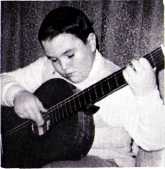 |
||
|
|
|||
|
|
||||
|
|
||||
|
music by Italian guitarist-composer Mauro Giuliani.)
Dr. Heck also wrote his dissertation on Giuliani (see CGI, Vol. 1, No. 1). In his dissertation, he wrote that the six-string classic guitar comes from Italy, partly basing his assertion on a guitar in a Stockholm, Sweden, museum, made in Marseille, France, by an Italian guitar maker. Heck wrote that the guitar bears the label "Lippy a Marseille 1787."
Guitar Review (No. 34) also carried an article by Heck on "The Role of Italy in the Early History of Classic Guitar." Referring to the Italian Federico Moretti, Heck wrote:
"His importance stems from the fact that both Sor and Aguado claim that he was the man who made them aware of the possibility of sustaining two or more parts on the guitar, and of accurately reflecting this fact in musical notation. Thus Moretti the Italian teaches the most influential of the Spanish early-19th -century guitarists how to play and write for the
|
 |
9
|
||
|
translated portions of the source: La Guitarra by Segundo Contreras, Buenos Aires: Emilio Perrot, 1927.
Contreras attributed the addition of the sixth string to Friar Miguel Garcia (Padre Basilio), who, according to Contreras "re-established the plucking technique and achieved such skill in its execution that his reputation extended beyond the walls of his cloister."
Basilio became court musician, Contreras wrote, "Thus, the guitar was rescued forever, and since has continued on its own path without adversely affecting any instrument and without permitting itself to be diminished by any other instrument."
Moretti began "to write music for this instrument so that it could be divided into two parts--melody and accompaniment.
|
||||
|
"So great was the interest inspired by these writings scattered in 1787 among friends, that in 1792, they induced hini to make his work public in Naples. He augmented and adapted his writings to the guitar of five strings since they were not familiar with the six-string guitar in Italy at that time.* When some copies were brought to Spain, it was decided to translate them immediately to Spanish. But since Moretti was in Madrid, he was urged to publish a new edition, which he did in 1799, calling it 'Principios para tocar la guitarra de seis (6) ordenes, prededidos de los elementos generales de la música,' because the edition was intended for the guitar that was played in Spain, even though Moretti himself used a seven-string guitar. This edition was published again in 1806, completely revised and augmented with new exercises."
So, we have two points of view. Heck contends that the six string classic guitar came from Italy because: 1. Of the unaltered six-string guitar in Stockholm and 2. Moretti taught
* Emphasis added.
|
||||
|
|
||||
|
classic guitar. The unavoidable conclusion is that the six -string guitar,
|
JUAN PAGES (Cadiz, 1788)
|
|||
|
which so many of us today regard as native to Spain, is —as an instrument of art music — of Italian origin, apparently owing only its figure-8 shape to Spain. It acquired its six strings, and its mensural notation in Italy."
Curious as to Heck's reference to the Spanish origins, CGI turned to one of the sources in Heck's dissertation. Marilyn K. Nicely, CGI librarian and Spanish consultant,
|
||||
|
|
||||
|
|
|||
|
10
|
11
|
||
|
|
|||
|
Sor and Aguado, two Spanish guitarists, to play and write for the classic guitar.
On the other hand, the Spanish language source found in the Heck dissertation, Contreras, asserted that Moretti wrote for the five-string guitar because the six-string guitar, of Spanish origin, was unknown in Italy at the time.
(Editor's note: Perhaps we can now hear from the Spanish, French, or other point of view. Does someone know of an unaltered six-string guitar earlier than 1787? Can someone be specific about that sixth string? Can someone furnish sources and/or translations?
Some curious omissions
(A BIBLIOGRAPHY FOR GROVE'S)
A proposed bibliography for the sixth edition of Grove's Dictionary of Music and Musicians by guitar historian Dr. Thomas Heck lists only two English language periodicals for guitar, Guitar Review of New York, and Guitar of London, England.
The bibliography excluded several English language guitar publications, including Guitar News and BMG of England and Guitar Player of the U. S.
Creative Guitar International wrote to Heck, asking officially why he chose the two magazines, leaving out the others, calling these omissions curious. CGI also asked to be included in the bibliography.
CGI sent Grove's a copy of the letter to Heck. Miss Helen Simpson, assistant to Grove's editor Stanley Sadie, replied, showing interest in the CGI letter.
After hearing from Heck, a CGI editor wrote Grove's the following:
Since I have received a reply from Dr. Heck, I
|
would like to tell you briefly how my request came about:
In the May, 1974 issue of the Soundboard, newsletter of the Guitar Foundation of America, was a notice that "The selective'guitar' bibliography for the new Grove's Dictionary (in press) is still available in typescript from the author. Send $1 to cover reproduction and postage to Thomas F. Heck, 3393 East Scarborough Road, Cleveland Heights, Ohio 44118."
I sent Dr. Heck $1 and received the bibliography copy. In it Dr. Heck wrote "Please write to me if you discover any serious omissions or errors, so I can relay these to Grove's Dictionary before the new edition hits the press." Therefore I wrote Dr. Heck my letter of Aug. 11 and sent a copy of it to you.
Dr. Heck replied: "I hope that you haven't caused me embarrassment by writing to the editors of that encyclopedia lodging your protest at my selection of periodicals.
"I trust that you will appreciate that my making available to scholars the results of my work for Grove's was a very unofficial action on my part. It isn't necessary to undertake an official reaction, and by doing so you may cause the Grove's people to come down hard on me for disclosing the contents of work contracted by them for their publication. It should be clear to you that you have no permission to refer to any part of my bibliography in print, and if you do so it will lead to bad blood between us."
|
||
|
The copy of the proposed bibliography Dr. Heck sent to me for $1 had no notice of copyright that I could find. In addition, the Classical Guitarist, newsletter of the Bay Area Classical Guitar Society in California contained a notice that the bibliography could be purchased for $1.
|
|||
|
|
|||
|
|
|||
|
13
|
|||
|
|
|||
|
12
|
|||
|
|
|||
|
Dr. Heck concluded: "I trust...that we can resolve the matter as it stands without having to have transatlantic correspondence with the Grove's editors."
In the May, 1973 issue of BMG, a British publication Graham Wade of England wrote an article "An Obituary for Guitar News," which accurately describes the magazine.
Wade wrote that "The editor (Wilfred Appleby) helped always by his wife Kay, founded a guitar society in Cheltenham, organized the first public recital of Julian Bream, and achieved for the magazine a reputation of international importance. Guitar News became a historic and vital record of the growth of the guitar's popularity throughout the world; the earliest editions are now of considerable value and a complete collection of the magazine's 119 editions would be worth its weight in gold for any researcher...
"A complete study of these early editions will yield an incredible amount of information; Segovia's complete itinerary is often listed for certain months,the gradual growth of the concert careers of Bream and Williams is carefully registered...
"The magazine never deviated from its purpose — to make more famous the classic guitar, and it never sullied its pages with a dillution of pandering to popular notions about the guitar."
Wade concluded that "The value of Guitar News as a historical record of the guitar is monumental; its importance is greatly in excess of the sum of the individual editions..."
In his dissertation, Dr. Heck used as a reference an article by Heck published in Guitar News. Heck also referred to this article in a summary of his works he
|
sent Creative Guitar International, and also another article he wrote for Guitar News, "Mauro Giuliani: Birth and Dates Established." (Guitar News No. 114).
When Dr. Heck received his doctorate from Yale in guitar, Guitar News reported it, carried a picture of him on its front page, and also carried a summary of his work. (Guitar News No. 112).
Creative Guitar International began when Guitar News folded without notice after issue No. 119. The Applebys have twice refused our request to use their mailing list. In the year we have published and gathered our own mailing list of classic guitarists around the world, we have come to respect the refusal by the Applebys. Perhaps you will understand that we have no special interest in Guitar News other than that of unbiased writing concerning that publication and other classic guitar materials, particularly since there are so few of international interest in English.
In view of your open minded reply to my letter, I thought I owed you the above explanation.
/Signed.
Sadie replied, saying he noted the points made in the CGI letter. He also wrote that the bibliography "has not been edited in this office."
|
||
|
Letters
|
|||
|
Following are excerpts of a letter received from Dr. Peter Danner, treasurer and archivist, Lute Society of America:
|
|||
|
"...your new magazine.. .is rather an improvement over the old Guitar News because it seems to adopt a somewhat more critical stance.
|
|||
|
|
|||
|
|
|||||
|
14
|
15
|
||||
|
|
|||||
|
"Many people will of necessity be relying on you to help them sort the wheat from the chaff. Considering the often disjointed nature of much of the guitar community, you can perform a valuable service to the instrument by opening lines of communication among guitarists.. .Your attention to the guitar and the very young is particularly praiseworthy."
Danner passed on the following information:
"In CGI (Vol. 1, No. 1) you asked about the guitar vis a vis the lute. (Julian) Bream is certainly not the only guitarist to double on this instrument. Particularly among younger players, guitarists are increasingly turning to it. Among players in the San Francisco area, Michael Lorimer and Joseph Bacon are two of the better known guitarists cum lutenists... Bream's lute playing is extremely guitaristic. Except for ornaments, left hand slurring was never utilized by Renaissance lutenists and the rest stroke was never used because of the double stringing. It is in order to facilitate rest stroke that Bream turned to using a single string on the second course as well as on the first. This stringing was only used on the later baroque lutes which were tuned not in fourths, but to an open D Minor chord.
"In reference to the comments made about Manuel Ponce in CGI (Vol. 1, No. 3), it appears that Ponce is responsible not only for the composition of Weiss's 'Suite in D,' but for the widely known 'Gavotte' hitherto attributed to Alessandro Scarlatti. The 'Gavotte' forms one movement of a suite by Ponce now edited in its entirety by Manuel Lopez Ramos and published by Peer International. About other Mexican composers, you might have mentioned publication sources. Also you might have mentioned Luis Sandi's suite for solo guitar, 'Fatima.'
|
MENC MUSIC LIST
|
||||
|
r
|
"The Music Educators National Conference in cooperation with the American String Teachers Association has formed a guitar committee to compile a graded list of guitar music to be included in their next Selective Music List. This list will be used by guitarists competing in state MENC competitions . The committee is being chaired by Dr. Roy Petschauer (Washington State University) and includes Dr. Peter Danner (PaloAlto, Calif.), Prof. Thomas Greene (North Providence, R. I.), Prof. Charles Postlewate (Flint, Mich.), and Prof. Ronald Purcell (Northridge, Calif.)
LUTE SOCIETY
"Many of your readers will be interested in the activities of the Lute Society of America (of which I am the treasurer and archivist.. .Although primarily concerned with the lute and its literature, the Journal of the Society (now in its seventh year) also covers historical aspects of the baroque guitar as well. In fact, the journal planned for this year appears to be more concerned with the baroque guitar than the lute. Membership inquiries can be sent to Box 194, Topanga, Calif. 90290.
(Editor's note: CGI wishes to acknowledge compliments by Dr. Danner and many others who have written, especially concerning the improvement in the magazine. We have you, the reader, to thank for this because of your participation in the magazine. As Danner suggests, we will continue to try to keep the lines of communication open.
(A source for the Mexican folk music arrangements was G. Ricordi & Co., Inc., en Mexico, Paseo de la Reforma 481-A, Mexico 5, D. F. Eduardo Balestrini A. of Ricordi wrote CGI: "...we hope that your effort to orient your readers within the beautiful field of music for the guitar may have the greatest possible success."
(The 12-volume set Composers of the Americas, Pan
|
||||
|
|
|||||
|
|
|||||
|
16
|
17
|
||||
|
|
|||||
|
American Union provides a comprehensive list of music by composers of the Americas and includes works for guitar.
(Unpublished works by Rafael Adame, reportedly the first composer in the Western Hemisphere to write a concerto for guitar and orchestra, are in the Edwin A. Fleisher collection in the Free Library of Philadelphia. See The Edwin A. Fleisher Collection of Orchestral Music, a Descriptive Catalogue, Vol. II, Press of Innes & Sons, Philadelphia, 1945. According to the catalogue, the Adame work is on negatives and loans to recognized symphony orchestras and colleges are possible.)
A CONCERT WORTH THE EFFORT
From James Kronmiller, Billings, Mont:
"It would be helpful to hear of master courses and workshops well in advance of the events. I tried to take part in the Parkening workshop in Colorado and received no answer from them.
"Incidentally, I went to the Christopher Parkening concert in Bozeman, Mont., May 8. I had to quit my job to get to go, but it was worth it."
(Editor's note—We will appreciate hearing from workshops as far in advance as possible with as complete information as possible. As Kronmiller points out, there are those willing to participate, if only they are informed ahead of time. Creative Guitar International deadlines are: Jan. 7, winter issue; May 1, spring issue; Sept. 7, fall issue.
A MEXICAN BIOGRAPHER FOR PONCE?
John Roberts of London, England, writes: Has any Mexican written a life of Ponce ? If so, what ?
(Editor's note: Our Librarian, Spanish and Portuguese consultant, Marilyn Nicely, helped us obtain the following
|
references on the Mexican composer:
|
||||
|
(Lopez Alonso, David: Manuel M. Ponce; ensayo biografico. 92 pp. includes "Preludio Roma'ntico, para piano solo" and "Estrellita" (1914) is in the University of Texas (Austin) Catalogue of the Latin American Collection, Vol. 24, p. 267.
(Mayer-Serra, Otto: Musica y Musicos de Latino-America. Vol. II, pp. 782-786. Published in Mexico in 1949.
(Romero, J.C.,"Efemerides de Manuel Ponce," Nuestra Musica, No. 2, 1950.
(Romero, Jesus C., La Musica en Zacatecas y Los Musicos Zacatecanos, UNAM, 1953.)
Publications received
|
|||||
|
*
|
Soundboard newsletter, Editor, Marteen Lee Poort, Ashbury Circle, Westminster, CA 92683.
The May, 1974 issue of the Soundboard announced that only Guitar Foundation of America members would receive future issues. Previously, all American String Teachers Association guitar members were to have received this newsletter.
The Soundboard is fuU of names and addresses of interest to guitarists, weighted toward the academic. It attempts to describe the status of research. It gives lists of guitar societies, periodicals, and includes music that can be reproduced.
The Soundboard solicits material, but stipulates: "The editor reserves the right not to print news of strictly local interest."
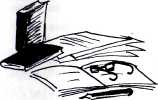 |
||||
|
|
|||||
|
|
|||
|
18
As of August, the GFA reported 130 members.
ALBUQUERQUE NEWSLETTER
Albuquerque Classical Guitar and Vihuela Foundation newsletter. Box 4351, Albuquerque, NM 87106.
SEATTLE NEWSLETTER
Seattle Classic Guitar Society newsletter. Write Wynn Smith, 2519 Monta Vista PI. W. , Seattle, WA 98199.
NEWSLETTER FOR MUSIC TEACHERS
GTML/Guitar Teachers Music Letter, Editor/Publisher, Fred W. Gagner, Box 55, Dover, N. H. 03820. Oriented to guitar teachers and studio-store operators of classes using steel and nylon strings. Gagner gives his recommendations and suggestions based on his experience as a teacher. He believes that the college level program should produce a musician who can teach several forms of guitar, banjo and mandolin.
NEWSLETTER FOR LUTHIERS
Guild of American Luthiers newsletter. President, J. R. Beall, Luthier, Rt. 1, Swan's Road, Newark, OH 43055.
The newsletter contains letters from makers and enthusiasts of the lute, dulcimer, piano, strings and different kinds of guitar. The May, 1974 issue featured an interesting review of seven instruments: vihuelas, lutes and a theobro used in concert by Rodrigo de Zayas, made by Fernando and Cesar Vera of Madrid. The lutes were built in the style suitable for concert hall use with red cedar tops of l/8" thick, fan braced like a guitar. The newsletter said "leaving the cedar thicker and using heavy bracing will maintain the traditional sound. The frets were ivory instead of tied gut or metal. The possibility of ivory frets was mentioned by Fray Bermudo in 1555, according to the newsletter.
The newsletter also reports that the London College of Furniture offers a three -year course in guitar making.
|
(Note reading, rhythm help) LoisShishido, Where's That Note ($3), and Basic Rhythms ($6), Box 127, Buena Park, CA 90621: By the author.
Lois Shishido divides the fingerboard into three areas: Low, middle and high positions. In using Where's That Note with my students I found that she told me things I already knew, but did not use. I suggest the teacher follow the study of locating notes with a particular study (i.e., Sor, Aguado, etc.) played in the middle or high positions. To reinforce learning, I suggest the left hand finger numbers be left off once the notes are learned. Many of us are guilty of reading numbers! Furthermore, I wonder why we look at our left hand in performance. Do we not know the fingerboard well ? Or it is just a habit?
When asked about her past musical experiences, Lois wrote that, because of her dislike for counting, she was a piano dropout. She attended the Universidad Nacional in Mexico City, where she received her master's degree in literature. She wrote that she "fell in love with Mexican music...naturally, the guitar played a prominent role in Mexican music."
She later met Kunio Aoki, a concert guitarist from Japan who is the co-author of Basic Rhythms. Basic Rhythms is based on syllables selected for their strong and weak sounds. Lois wrote that syllables can be read or sung faster than counting numerals, especially fast notes which are sometimes impossible to count.
Aoki began guitar at 20 and developed his own method of teaching. His students are noted for their sight reading and ability to memorize. Aoki believes an artist should be exposed to all forms of music, and should not spend all the time memorizing or practicing pieces to perform on the stage.
 |
||
|
|
|||
|
|
||||
|
20
|
||||
|
|
||||
|
Lois conducts rhythm workshops in Orange County (near) Disneyland) and her basic rhythm students include college and university theory professors.
"We do not use any musical instruments," she writes, only supplementary materials for reading solos, duets and ensembles together. Lois, we welcome help on two very serious problems—reading notes and complicated counting. I recommend and use Basic Rhythms and Where's That Note because they work.
Practicable practice
John David Roberts, The Snag and the Exercise, Valencia, Spain: By the author,
In practicing a piece, when we come upon a brief portion that we don't seem to be able to control, we have encountered what Roberts calls a snag.
To gain control of the snag, Roberts suggested an exercise, worked out methodically, which is merely a movement or series of movements to improve technique.
Roberts' booklet is a thoughtful work on how to practice:
"Technique has to deal with both wanted and unwanted movements, " he wrote. "A good technique should pass almost unnoticed.. .An exercise is better without musical meaning." He also said the shorter and simpler the exercise, the better, and that one of the hands should have a simple task. For example, in practicing "an arpeggio to remove a fault in the right hand, the left hand should play easy chord changes" or open strings. If the theory of an exercise is understood, he wrote, the exercise will never be dull.
Shifting and stretching are two types of left hand exercises. "Improve the right hand and the left hand will follow but the converse is not true," Roberts stated.Overcoming the snag should be limited to a single position change.
Roberts, from London, England, taught guitar to his
|
73-year-old mother, who was recently scheduled to give her second concert.
EVENING GUITAR CLASS
Subscriber Pat Maxin teaches an adult evening guitar class at the Community College of Allegheny County (Pa.) She teaches notes in the first position with one string each lesson, and tries to encourage sight reading without the use of numbers. Instead of performing herself, she encourages the students to play for the group.
GUITAR AND THE MASS
Subscriber Sister Antonice wrote that guitar is offered at the Holy Family Conservatory, Manitowoc, Wis. She prefers the classic style in her guitar masses, and is interested in children's ensemble music for concerts and recitals. (See chamber music, CGI, Vol. 1, Nos. 2 and 3).
|
|||
|
EXTENSION COURSE
The Classical Guitarist reports that Stanford lecturer Charles Ferguson is holding an extension course this fall in "Classical Guitar Interpretation and Maintenance. "
(Editor's note: Write CGI if your community is sponsoring guitar programs in a local university. If you are a teacher you might wish to make your services available and thus initiate a classic guitar program in a school which might not otherwise have one.)
|
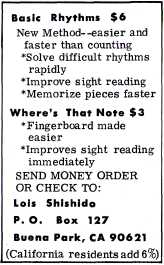 |
|||
|
|
||||
|
|
|||
|
Finish touch-ups, matching colors
By Neil Pennington Many times in the course of repairing cracks, broken headstocks, scratches, and the like, it is necessary to touch up the repaired spot in such a manner as to make it indistinguishable from the surrounding surface.
To understand the problems involved in matching a color, it is important to realize that in most cases where it has been necessary to sand to the bare wood, three different surfaces have been exposed: l)the wood itself, whichmay or may not be stained; 2) a surrounding area of untinted sanding sealer; and 3) an area of lacquer or acrylic, which is probably tinted. Hence, the area to be touched-up appears something like this when viewed from the side:
|
23
|
||
|
2. With the tip of the finger, apply a layer of Mohawk Blendal Stain, of the proper shade, to the entire repair surface. Sometimes, in order to make the powder adhere to the natural wood, it is necessary to moisten the tip of the finger before spreading the powder.
3. Remove any powder from the surrounding surface.
4. Apply a light coat of Mohawk Lacquer Sanding Sealer. Allow to dry for about one minute, then rub very lightly with #0000 steel wool.
5. Repeat the procedure applying powder only where needed to darken an area. Since the pigment diffuses into the lacquer, if an area is made too dark, it may be lightened by sanding.
|
|||
|
|
|||
 |
6. Once the desired shade has been obtained, level the surface by applying, and then sanding, clear coats of lacquer sealer. (Note: The Mohawk products are designed for professional use and hence dry quite fast. However, since each succeeding coat softens the ones below, after about four to five applications, allow the spot to dry for about 15 minutes).
7. Apply two to three coats of Mohawk Satin, Gloss, or Acrylic. Allow to dry about 30 minutes.
8. Rub with Antiqua rubbing compound and polish with Antiqua wax until the sheen matches that of the original finish.
A systematic procedure will reduce set-up time and promote more efficient operation.
(Editor's note: This is the first of a series of articles on guitar repair planned by Neil Pennington, who is a guitar instructor at the University of Maryland, Baltimore campus; and Goucher College. CGI invites readers to offer suggestions for topics and ask questions in the field of guitar repair and making, or other aspects of the classic guitar.)
|
||
|
From this it may be seen that staining the wood will not be effective, nor will using a tinted lacquer; the result will usually be an uneven coloration since the base consists of three different shades. What is needed is a method whereby the pigment may be applied exactly where needed. With a little practice, the following method, using dry blending stains and spray touch-up lacquer, will produce a fast, professional job. *
1. If necessary, fill the wood surface with a paste wood filler. If the filler must be colored, a dry blending
stain may be used.
|
|||
|
*The products listed in this article are often for professional use only, and may be difficult to find. They may be purchased by mail from: Terpsichore Musical Products, Box 9778, Towson, MD 21204.
|
|||
|
|
|||
|
|
||||
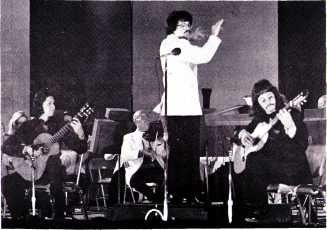 |
25
dancers and singers from Spain. The two Romeros have performed for the Sante Fe Opera.
ACTIVITIES INCREASE IN COLUMBUS
Paul Hinrichs reports that Ohio State University opened a guitar program in the spring under instructor Bruce Everett.
Hinrichs writes that Everett "has a great knack for making the guitar newsworthy, probably assisted by his background in advertising. The embryonic OSU guitar ensemble has appeared on local TV and radio." Also a guitar series has been initiated on the local WOSU-FM radio.
|
|||
|
BEHREND CONCERT IN RED DEER
Subscriber Dr. Robert Burt of Red Deer, Alberta, Canada, wrote that the local German-Canadian Club sponsored a concert by Siegfried Behrend. At a reception following, Behrend played Dr. Burt's latest guitar, a model constructed by the doctor himself! Dr. Burt's teacher is Peter Higham, who studied with Hector Quine in London.
|
||||
|
MIGUEL (L) AND RUBEN PERFORMING VIVALDI
Chamber group backs Romeros
Brothers Ruben and Michael Romero performed Vivaldi's "Concerto in D Major" on a recent program given by the Denver Symphony Orchestra.
The Romeros, of Sante Fe, N. M. , were accompanied by a small string ensemble.
The Romeros also played other styles of music, including compositions and improvisations of their own. The two brothers have made two records in an interesting attempt to synthesize the classic style and art music with more popular music.
Ruben studied piano at ten and guitar at 12. He performed as a guitarist in another brother's dance troupe, saving enough money to spend a year in Spain.
In 1970 his family opened a restaurant, which imports
|
||||
|
HONG KONG SUBSCRIBER
|
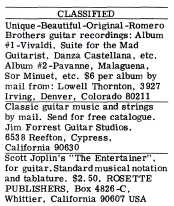 |
|||
|
"I am glad to know that you are publishing a magazine similar to Guitar News," wrote C. C. Chang of Hong Kong, "especially when I had been a subscriber for over 12 years." He also said he was planning to organize some kind of classic guitar society, and that competent professional classic guitar teachers are needed in Hong Kong.
|
||||
|
|
||||
|
|
||||
|
26
|
||||
|
|
||||
|
FUTURE Oct. 10, Julian Bream, Wisconsin Union Theater, Madison, Wis., 8p.m. Nov. 13, John Mills of England, Seattle Pacific College,Seattle,Wash.,8 p.m.
Feb. 16, The Romeros Quartet, Wisconsin Union Theater, Madison, Wis.,8 p.m.
Mar. 5, Argentinian Zarate Guitar Quartet, Ohio State University, Columbus, Ohio.
1975--A nationwide hearing over National Public Radio was planned for early 1975 of the "Concertino for Guitar and Chamber Orchestra" by Andre Casanova. The hearing will be of a tape of the premier performance of the work by the Richmond (Va.) Sinfonia last winter. Soloist was guitarist John Barlow.
1975--Seventeenth Concours International de Guitare. For information write France -Musique, 116, av. du President-Kennedy, 75790 Paris, Cedex 16, France.
To be scheduled -- Grete Dollitz was guest artist on a community concert presented by WRFK-FM, Richmond, Va. A tape presentation will be made, with commentary on the works.
|
Classic Guitar
Teacher
Directory
|
27
|
||
|
RECENT
|
||||
|
Frederick Noad,Seattle Pacific College,followed by one-week workshop sponsored by the Seattle Classic Guitar Society.
Hatsumi Kajikawa, Mainichi Bunka Hall, Osaka. Later (Sept. 30) she performed "Concierto de Aranjuez" with the Veille Chamber Orchestra.
|
||||
|
As an introductory offer, we will list you or your studio, along with address, under the heading "Classic Guitar Teacher Directory" for $5 a year prepaid (3 insertions, fall, spring and winter). Extra Words $1 (phone $1). Fill out the enclosed form or send your name and address along with $5 to: Directory, Creative Guitar International, Box 1275, Edinburg,
Texas 78539_____________________
JIM FORREST GUITAR STUDIOS
6538 Reefton Ave.
Cypress, Cal. 90630
Phone (714) 892-2739 2-3
|
||||
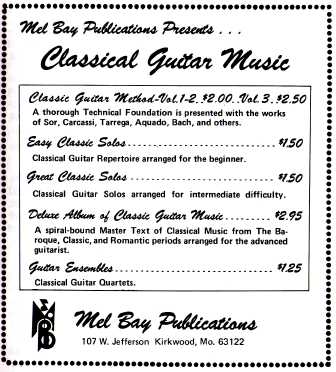 |
||||
|
GREGORY FOX
3108 N.E. 40th Avenue
Portland, Oregon 97212 2-3
JOSEPH I. GALLUCCI
165 Augusta St.
Irvington, New Jersey 07111 2-3
PAUL HINRICHS
144 W. Norwich
Columbus, OH 43201 2-3
Phone (614) 299-4037
SONIA MICHELSON
6709 North Mozart Street 2 -3
Chicago, Illinois 60645
DAVID SUSSMAN
26 Clifton St. 2 -3
Belmont, Mass. 02178
Phone (617) 484-2030
DIANA TODD
Rogers Park, 2-3
Chicago, Illinois
Phone 338-1118
|
||||
|
|
||||
|
|
||||
|
28
|
29
|
|||
|
|
||||
|
Workshops:
|
||||
|
|
||||
|
Interesting excursions
"Four Excursions for Guitar and Flute," by Frederic Hand. $5. Boosey & Hawkes.
Frederic Hand, born in 1947 in New York City, studied with Julian Bream in Canada and on aFulbright scholarship in England. He has composed and performed sound tracks for films, among them "Match" (Aldeburgh Festival, England).
"Four Excursions for Guitar and Flute" is demanding for the guitar, but exciting, interesting and worth the work. If is in a 20th century idiom, but tonal. More American composers of Hand's calibre are needed for guitar.
According to the publishers,thereisa recording included in a Golden Crest Recital Series entitled "Miniatures for Classical Guitar and Flute," RE 7046, Frederic Hand, guitar, and Andrew Lolya, flute. Grade 5. Difficulty scale, 1-6).
LOOKING FOR SOMETHING DIFFERENT?
"Look, lady, we don't sell your kind of music," a local music store dealer told one of my students. She sought something in the lighter, popular style in classic guitar notation. I showed her Scott Joplin's "Entertainer," easy and playable, arranged by Lee Stryker ($2.50, Rosette Publishers, Box 4826, Whittier, CA 90605.)
Kent Sidon, founder of the Guitar Workshop (New York) sent "Opera House Rag" (RobertDarch, 1960) and "Sunflower Slow Drag" (Scott Joplin and Scott Hayden, 1901). Transcribed and edited by Marcel Robinson, $1.25 each, Theodore Presser Co., Byrn Mawr, PA 19010.
I recommend that teachers have access to this music, as
it often can help hold on to a teenage student.
Ruth Mock
|
Performance as soloist
|
|||
|
Mario Beltrán of Mexico gave a concert in Edinburg, Texas on two weeks notice. Beltrán switched to a solo performer after his duo partner, Maricarmen Costero, became ill the morning of a planned Edinburg concert.
Patrick Read, California manager of the duo wrote that: "The duo...decided not to play together any more. Maricarmen doesn't want a concert career. She wants to edit music
|
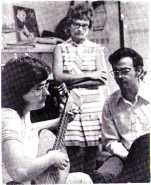 |
|||
|
|
||||
|
and teach."
Other U.S. concerts by the
|
BELTRÁN AND STUDENT MASSEY (RUTH MOCK IN BACKGROUND)
|
|||
|
duo were cancelled.
Beltrán also gave a class the next day in Edinburg, with students ranging in age from six years to adult, including: Janice Campbell, Cindy Cole, Kathleen LeFevre, Kati Massey, Edward Miner, Melody and Nelson Mock, and Joe Ranson.
Among comments made by Beltrán to the performers:
*Follow the exact fingering of both hands.
* Exact coordination of both hands is necessary.
*Use less finger movement of the right hand.
*Hold a pencil or a coin between the thumb and index finger of the right hand to keep the thumb extended out from the hand. If the pencil drops, the thumb is incorrectly placed. Once you keep your thumb close to your hand, the rest of the fingers will automatically go in place.
|
||||
|
|
||||
|
|
|||||
|
31
|
|||||
|
|
|||||
|
30
|
LOPEZ RAMOS SEMINAR
The Rev. Daniel A. Creagan reported the performance level was at an all-time high at the fourth annual seminar given by Manuel Lopez Ramos at Spring Hill College in Mobile,Ala. Performers included Steve Klein, Tony Arce, Lou Gehring, Pamela Kimmel, Helene Rottenberg, Al Kunze, Sam Martinez, Diane Bault, Danny Hazard, Mat Mis-chakoff, Jean Collins, Manuel Fraguela, Jim Pringle and Ralph Irazarry.
|
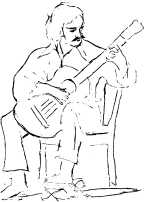 |
|||
|
*Left hand problems may be caused by slanting the guitar.
|
|||||
|
*Sit forward on the chair to control the legs.
Beltrán (see Vol. 1, No. 1) was asked the value of the flat hand position. He replied that although the position is not very natural ("muy poco natural") and is very difficult, the sound produced is better.
PENCIL HELPS HAND
Following the class, Beltrán wrote that he hoped the class he gave "may have served if only in a small way to motivate and inspire your students, who are playing very well." And "las pequenas correcciones que les nice son eso mismo 'pequenas' asi'que espero que sigan progresando mucho. " Beltrán is touring Europe as a soloist this fall, playing in Berne, Switzerland; Nancy, France; Vienna, Austria; Rome, Italy; Brussels, Belgium; and Gerona, Alicante, Granada, Cadiz and Madrid, Spain. He also plans a tour of the U.S. in the spring.
ABLONIZ PERFORMERS
The following performed at the sixth Abloniz master class at Ithaca College, Ithaca,NY: From the U.S., John Bigelow, A.Keith Carreiro, Patrick Caruso, Dimitri Erdely,Richard Georing, Paul J. Greaver, Lin Green, Mrs. Melva Grogan, Paul Hinrichs, Charles Harry King, Mrs. John Lucas, Richard Mizerny, James Post, Don Ross, Mitchell Schuld-man, Katherine Schas, Linda Spagnoli, Will J. Stewart IH, and Cynthia L. Canfield; from Canada, Neil J. Bateman and John Dykes; from Vienna, Austria, Steven Janas.
GHIGLIA CLASS
John Scammon reports the master class offered annually at Aspen, Colo., by Oscar Ghiglia, will be five weeks next year.
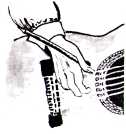 |
|||||
|
|
|||||
|
Efrain Flores, violin instructor in the Dallas public school system, |
INTERPRETER FRANK COSTA AT WORKSHOP
|
||||
|
audited as a guitarist. He pointed out that Diana Bault and Matthew Mischakoff also are violinists. Lopez Ramos gave a concert in connection with the class. One selection was "Allegro" by California composer Peter Madlem.
|
|||||
|
Guitar on campus
Baldwin-Wallace College of Berea, Ohio, offers a BME with requirements of a minor instrument and piano skills. Prospective students must audition. Baldwin-Wallace has a guitar ensemble which performs music mostly from the Renaissance period.
|
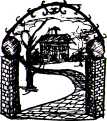 |
||||
|
Professor of guitar is Dr.Loris Chobanian,who received his Ph. D in composition at Michigan State University. He was soloist in the premier performance of his "Concerto for
|
|||||
|
|
|||||
32
|
33
Aandahl's collection grew with his interests in the guitar. He has music from many lands, including tapes of about 700 pieces from rare78rpm discs acquired from Ronoel Simoes of San Paulo, Brazil.
Aandahl has "recordings and tapes of Andres Chazzareta, Miguel Llobet, Maria Louisa Anido, Anido-Llobet duets, Augustin Barrios. . . Emilio Pujol, Atahualpa Yupanqui, Eduardo Falu, and many others..."
Aandahl teaches math in the Denver public schools, guitar privately and at Metropolitan State College. While rehearsing for a concerto for guitar and orchestra (Ramon Noble's "Concertino Mexicano") Aandahl strained three tendons. He refingered and performed the music, but has had to quit playing despite surgery and acapuncture treatments.
On occasion, Thornton has had performers on his show, such as Jean-Pierre Jumez and Christopher Parkening. He includes short biographical sketches of artists, as well as sidelights about guitarists.
Aandahl said he hopes some day to "Organize a series of tapes that would provide a comprehensive picture of guitar music--historical and regional."
"I also have many periodicals, books, newsletters, etc., including about 40 years of BMG, all Guitar News, and all of Guitar Review. The problem is how to make all of this available to others interested in guitar history."
|
||||
Guitar and Orchestra," by the Michigan State University Symphony Orchestra.
SOUTHERN ILLINOIS
Southern Illinois University at Carbondale offers a BM and MM in performance in classic guitar. Offered is private instruction, beginning guitar classes, and a guitar ensemble class.
Instructor John A. Scammon, with two guitar degrees, has attended master classes under Alirio Diaz, Emilio Pujol, Michael Lorimer and Oscar Ghiglia. Tom Strini is a graduate assistant instructor.
|
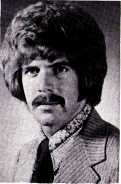 |
||||
SCAMMON
|
|||||
The repertoire includes the Pujol method, Vols. II-IV. The first year includes studies from Sor, Carcassi and Ponce.
Strictly guitar
|
|||||
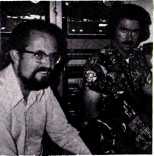 |
In his Denver radio program, "Strictly Guitar," Lowell Thornton has access to a collection of guitar records started 18 years ago.
The collection of more than 1,200 guitar records was made by Vaughn Aandahl, who like Thornton is a guitarist and teacher.
|
||||
Wanted for Our files:
|
|||||
AANDAHL (L), THORNTON
|
"Strictly Guitar" is a half-hour program heard over KVOD-FM, a fine arts station.
|
Guitar Review Nos. 8-10 and 12-15; Guitar News prior to No. 90. Please state price and condition. Creative Guitar International, Box 1275, Edinburg, TX 78539.
|
|||
|
|
|||||
|
Fi rst graduate
|
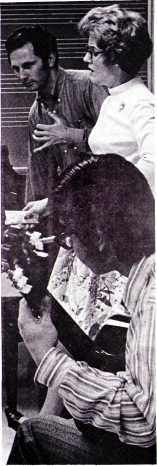 |
Records:
|
35
|
||
|
The sound that evades so many
"Antologia de la Guitarra Clasica," by Manuel Lopez Ramos. Angel, SAM 35024.
This record was purchased in a Mexico City record shop for $10. To date it is unavailable in the U.S., and what a pity. It contains selections from "Platero y Yo," by Mario Castelnuovo Tedesco, "English Suite" by John W. Duarte, "Siciliana" by Carl Philipp Emanuel Bach, "Dolor" by Donostia, and the evasive "Suite," by Manuel Ponce, once attributed to the German Leopold Sylvius Weiss. It was, according to the jacket, written for Andres Segovia, and attributed to Weiss "por mutuo acuerdo" (by mutual accord).
In this record Lopez Ramos displays the appealing sound that evades so many. Ramos carries the guitar above the harpsichord tone too often heard on the guitar. In his hands, the guitar becomes, for once, a real string instrument, with a scope challenging that of the bowed string instruments. His rich vibrato comes through with a clarity seldom heard on a guitar record. His rest stroke provides a legato of nearly "singing tone" proportions, with articulation that displays a command of the fingerboard. This record illustrates why followers of Lopez Ramos defend the flat hand position almost fanatically.
Why won't Angel, or some record company, release another Lopez Ramos record in the U.S?
|
|||||
|
George Pulmano of Seattle, Wash., planned to become an engineer, but heard about a new guitar program developed at Washington State University by Dr. Roy Petschauer.
This spring, Pulmano became the first graduate of the program. The curriculum offers classic guitar instruction, accompanying classes, duo and ensemble performance practices, and guitar pedagogy.
Pulmano performed in a recital with Earle Bower and Frederick Sandmeyer. Pieces also included voice and flute.
Some recital music was sent by Brazilian guitarist Laurindo Almeida, who airmailed it to Washington State whenhe heard of Petschauer's search for his music. Included were Almeida's transcription of Faure's "Sicilienne" as well as a work of his own for solo voice, drum and guitar.
Pulmano also appeared as soloist with the university chamber orchestra.
|
|||||
|
If you are moving:
|
|||||
|
Please let us know three weeks
|
|||||
|
|
|||||
|
GUITARIST PULMANO
WITH DR. PETSCHAUER
AND VOCALIST
|
before you change your address
|
||||
|
|
|||||
|
|
||
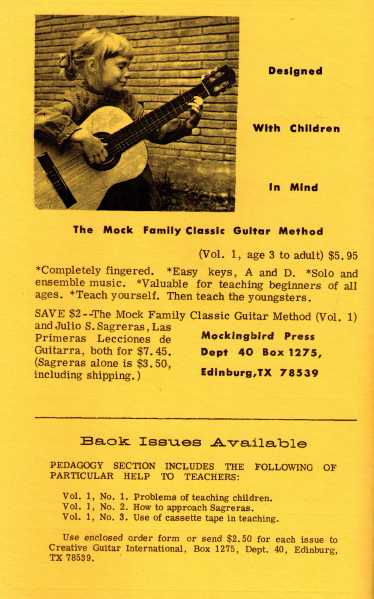 |
||
|
|
||